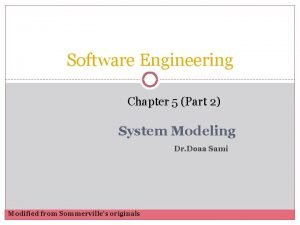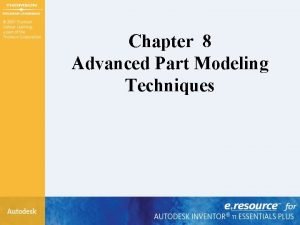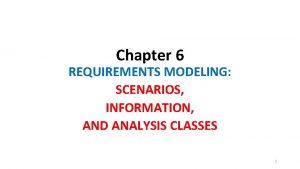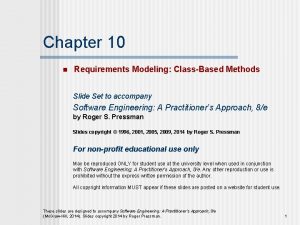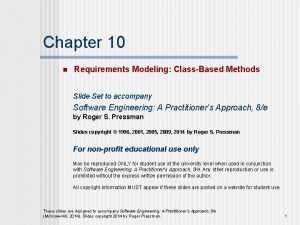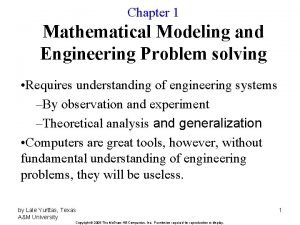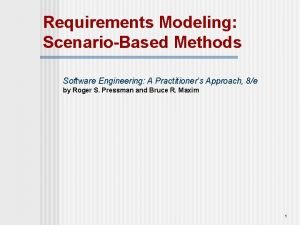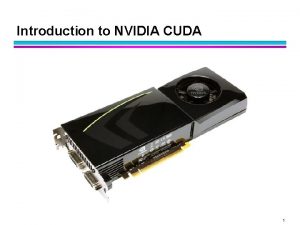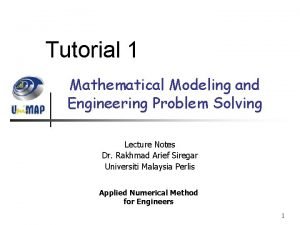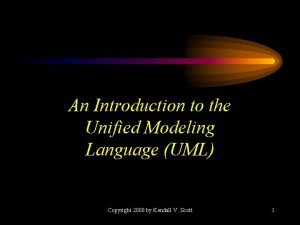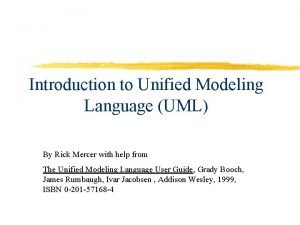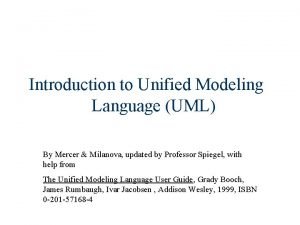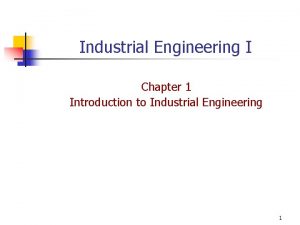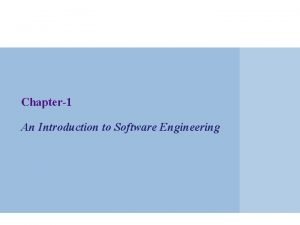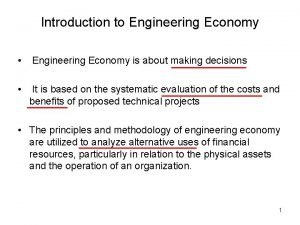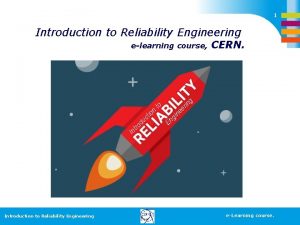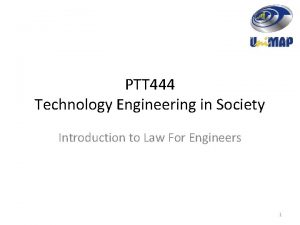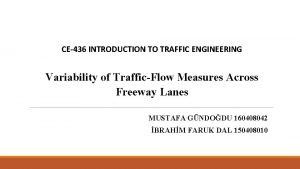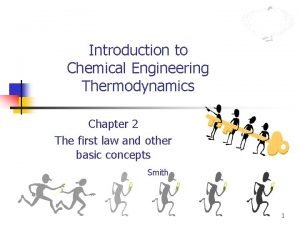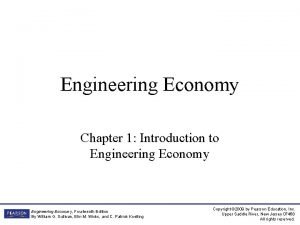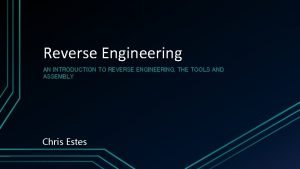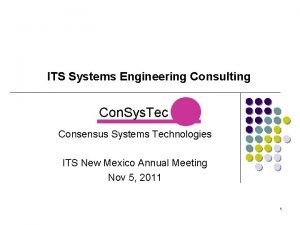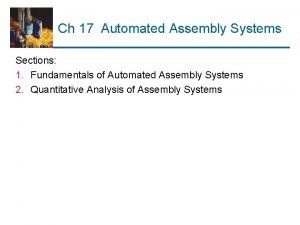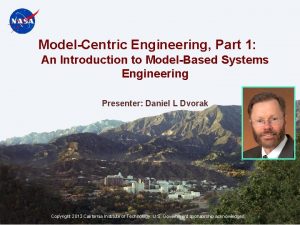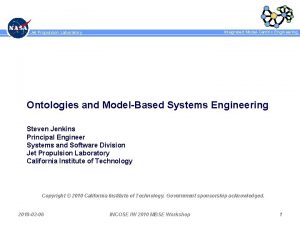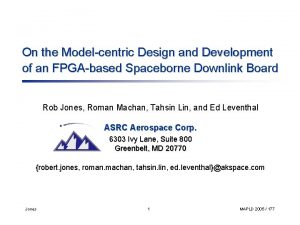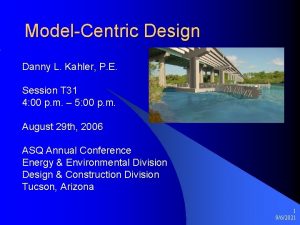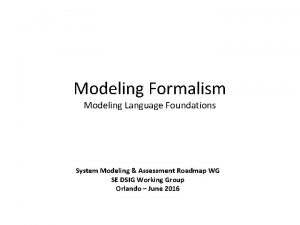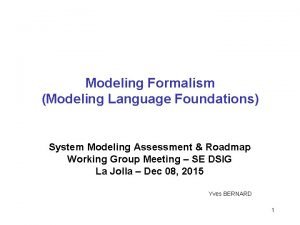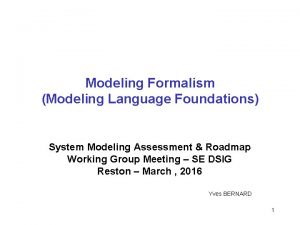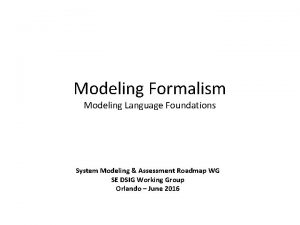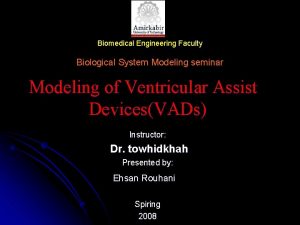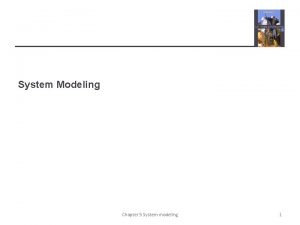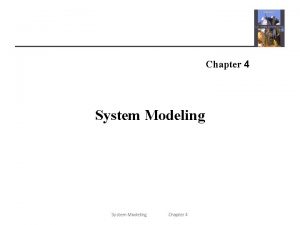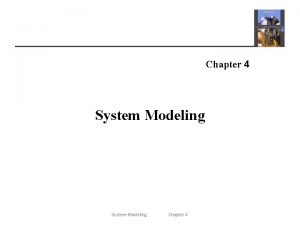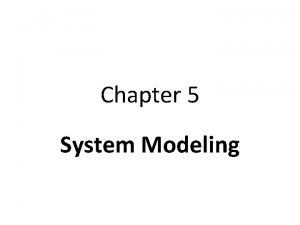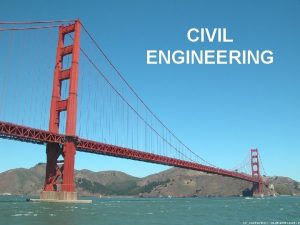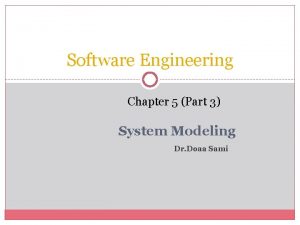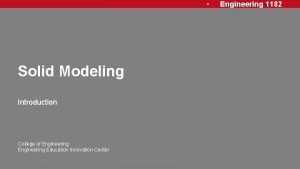ModelCentric Engineering Part 2 Introduction to System Modeling









































































- Slides: 73

Model-Centric Engineering, Part 2: Introduction to System Modeling SEWG MBSE Training Module 2 https: //nen. nasa. gov/web/se/mbse/documents Todd Bayer, Daniel Dvorak, Sanford Friedenthal, Steven Jenkins, Chi Lin, Sanda Mandutianu Jet Propulsion Laboratory, California Institute of Technology Copyright 2012 California Institute of Technology. U. S. Government sponsorship acknowledged.

Objective and Intended Audience Model-Based Systems Engineering Objective: • Understand good practices in the development and use of system models Intended Audience: • Systems engineers and discipline engineers (practitioners) Prerequisites: • Systems engineering background • No Sys. ML tool experience required Non-Objectives: • Not Sys. ML training • Not tool training • Not a sales job Introduction to Modeling 2

Outline Model-Based Systems Engineering • Take-aways from Module 1: “Systems Engineering with System Models” • System Models • Good System Models • Sys. ML Basics and Customization • Methodologies and NASA Systems Engineering Process • Summary Introduction to Modeling 3

Acknowledgements Model-Based Systems Engineering Funding: NASA SEWG MBSE initiative (Steve Kapurch, HQ) JPL ESD Integrated Model-Centric Engineering (Chi Lin, JPL) JPL Systems & Software Division (David Nichols, JPL) Contributors: Todd Bayer, Daniel Dvorak, Sanford Friedenthal, Steven Jenkins, Chi Lin, Sanda Mandutianu Other Sources: JEO/EHM modeling effort JPL Modeling Early Adopters (MEA) Introduction to Modeling 4

Take-aways from “Systems Engineering with System Models” Model-Based Systems Engineering • MBSE is systems engineering … with models – MBSE formalizes part of systems engineering • MBSE addresses SE problems of complexity, architecture, integration, reuse, and technical/programmatic coupling • A system model … – integrates info from discipline models – becomes part of the technical baseline – serves team as single source of truth • Needed infrastructure … – Tools, training, standards, methodology • Multi-pronged, evolutionary infusion strategy recommended – Culture change takes time Introduction to Modeling 5

Model-Based Systems Engineering SYSTEM MODELS • • • What is a model? What are some purposes for modeling? What does a system model contain? What are the different types of models? How are the different types of models integrated into the overall engineering effort? Introduction to Modeling 6

What is a Model? Model-Based Systems Engineering • A model is a representation of one or more concepts that may be realized in the physical world • A model is an abstraction that does not contain all the detail of the modeled entity – The reason to abstract is to highlight parts of the world needed to understand and/or address a problem • Models are represented in many forms including graphical, mathematical, and logical Introduction to Modeling 7

Some Purposes of Modeling Model-Based Systems Engineering • Characterize an existing system • Specify and design a new or modified system – – – Represent a system concept Specify and validate system requirements Synthesize system designs Specify component requirements Maintain requirements traceability • Evaluate a design – Conduct system design trade-offs – Analyze system performance requirements or other quality attributes – Verify that the system design satisfies its requirements – Assess the impact of requirements and design changes • Train users on how to operate or maintain a system • Shorten the time needed to get an accurate understanding of a system Source: A Practical Guide to Sys. ML: The Systems Modeling Language, by Friedenthal, Moore, and Steiner, 2008. Introduction to Modeling 8

System Model Contents Model-Based Systems Engineering A system model describes … • The problem the system is intended to address – Requirements – Use cases • Both hardware and software • The structure of the system – The organization of components within the system – The structure of the data flowing in and out of the system and its components • The behavior of the system – State descriptions – Sequence descriptions – Algorithmic descriptions • Analyses of the system Introduction to Modeling 9

System Model and Other Discipline Models Model-Based Systems Engineering Structural Model Electrical Model Instrument Models System Model “System Model” Coupled models of structure, Spreadsheets, viewgraphs, behavior, requirements, and text documents, e-mails, equations. Single source of meeting notes, etc. truth. Checkable. Queryable. Thermal Model Introduction to Modeling Telecom Model Software Model 10

Model-Based Systems Engineering WHAT MAKES A SYSTEM MODEL GOOD? • • Modeling notation expressive enough for the domain Conveys the conventional domain wisdom Semantics of model elements unambiguous Model is complete Can answer pertinent questions about the domain Supports reasoning about the model and the design Support reasoning about programmatics Supports required analyses Introduction to Modeling 11

How a System Model Helps Model-Based Systems Engineering A well-structured system model can be analyzed to answer many questions • Does every component trace to a requirement? Yes • Have both sides of every interface been specified? No! • What is the dry mass of the flight system? 479 kg System Model • What is the maximum load on power bus 3? 14. 7 A • Is every terminal connected? Yes • What is the mass rollup? Introduction to Modeling Mass Report 12

Is This A Model? Model-Based Systems Engineering ground system spacecraft receive telemetry transmit telemetry packet Introduction to Modeling Sure, why not? 13

Is It A Good Model? Model-Based Systems Engineering ground system spacecraft receive telemetry transmit telemetry packet Not so much. It is just boxes and lines with no clear meanings. Introduction to Modeling 14

What’s Wrong With It? Model-Based Systems Engineering ground system spacecraft receive telemetry transmit telemetry Same symbol for different kinds of things Introduction to Modeling telemetry packet Same symbol for different kinds of relationships 15

Better? Model-Based Systems Engineering ground system spacecraft transmit telemetry receive telemetry packet Introduction to Modeling Not much. Essential distinctions are merely suggested. They should be explicit. 16

Making Distinctions Explicit Model-Based Systems Engineering • Rather than merely hinting at distinctions with shapes or colors, we could devise a set of types or classes to be applied to model elements • The set of types is application-dependent – Systems engineers talk about different things from chefs – The distinctions are whatever matters for your application – Is red wine a different type from white, or is is merely a property of wine? • It depends on what you want to say about wine • What kinds of things do systems engineers talk about? – Component, Interface, Function, Requirement, Work Package, Product, Process, Objective, Message, etc. • Let’s apply some classes to our model • For now, every element has – one type, denoted like this: «type» – one name, which identifies an individual of that type Introduction to Modeling 17

Model With Typed Elements Model-Based Systems Engineering «component» ground system spacecraft «function» receive telemetry transmit telemetry «message» telemetry packet Introduction to Modeling Much better. 18

Answering Questions Model-Based Systems Engineering What components are present? «component» ground system spacecraft «function» receive telemetry transmit telemetry «message» telemetry packet Introduction to Modeling 19

Answering Questions Model-Based Systems Engineering «component» spacecraft What functions are present? «component» ground system «function» receive telemetry transmit telemetry «message» telemetry packet Introduction to Modeling 20

Answering Questions Model-Based Systems Engineering «component» spacecraft What messages are present? «component» ground system «function» receive telemetry transmit telemetry «message» telemetry packet Introduction to Modeling 21

Add Typed Relationships Model-Based Systems Engineering «component» ground system spacecraft «performs» «function» receive telemetry transmit telemetry «sends» «message» telemetry packet Introduction to Modeling «performs» «receives» Note that relationships are now directed. 22

More Questions and Answers Model-Based Systems Engineering «component» spacecraft «performs» What component performs the function transmit telemetry? «function» ground system «performs» receive telemetry transmit telemetry «sends» «component» «message» «receives» telemetry packet Introduction to Modeling 23

More Questions and Answers Model-Based Systems Engineering «component» spacecraft «performs» What functions does the component ground system perform? «function» ground system «performs» receive telemetry transmit telemetry «sends» «component» «message» «receives» telemetry packet Introduction to Modeling 24

More Questions and Answers Model-Based Systems Engineering «component» spacecraft «performs» What messages does the function transmit telemetry send? «function» ground system «performs» receive telemetry transmit telemetry «sends» «component» «message» «receives» telemetry packet Introduction to Modeling 25

More Questions and Answers Model-Based Systems Engineering «component» spacecraft «performs» What components perform a function that sends or receives the message telemetry packet? «function» «message» telemetry packet Introduction to Modeling ground system «performs» receive telemetry transmit telemetry «sends» «component» «receives» Alternatively, what component designs may be affected if the definition of telemetry packet changes? 26

Reasoning About Models Model-Based Systems Engineering • We can use models to answer questions • The questions may be about the system itself – – What is it? How does it work? Is the performance adequate? What happens if something breaks? • The questions may be about the model – Is it complete? – Is it consistent? – Does it support required analyses? • The questions may be about the design artifacts – Are all required documents present? – Does each document contain all required content? • We call answering these kinds of questions reasoning – It doesn’t necessarily mean exotic, artificial intelligence Introduction to Modeling 27

Reasoning About Completeness Model-Based Systems Engineering «component» What components perform no function? spacecraft «function» ground system «performs» receive telemetry transmit telemetry «sends» «component» «message» «receives» telemetry packet Introduction to Modeling 28

Reasoning About Completeness Model-Based Systems Engineering «component» spacecraft What functions are not performed by any component? «function» ground system «performs» receive telemetry transmit telemetry «sends» «component» «message» «receives» telemetry packet Introduction to Modeling 29

Reasoning About Completeness Model-Based Systems Engineering «component» spacecraft «performs» What messages are received but not sent? «function» «component» ground system «performs» receive telemetry transmit telemetry «message» «receives» telemetry packet Introduction to Modeling 30

Reasoning About Completeness Model-Based Systems Engineering «component» spacecraft «performs» What messages are sent but not received? «function» ground system «performs» receive telemetry transmit telemetry «sends» «component» «message» telemetry packet Introduction to Modeling 31

Reasoning About Consistency Model-Based Systems Engineering «component» spacecraft «performs» Are there illegal or meaningless relationships in the model? «component» «sends» «function» transmit telemetry «sends» «message» «function» ground system «performs» receive telemetry «receives» telemetry packet Introduction to Modeling 32

Reasoning About Design Model-Based Systems Engineering Each component has: • allocated mass (ma) • estimated mass (me) «component» spacecraft me: ma: 130 kg «contains» «component» telecom me: ma: 35 kg «component» amplifier me: 8 kg ma: 10 kg «component» antenna me: 19 kg ma: 20 kg «component» propulsion me: ma: 80 kg «component» me: 38 kg ma: 44 kg me: 30 kg ma: 29 kg tank thruster me: estimated mass ma: allocated mass Introduction to Modeling 33

Reasoning About Design Model-Based Systems Engineering Each component has: • allocated mass (ma) • estimated mass (me) «component» spacecraft me: m 95 e: kg ma: 130 kg «contains» «component» telecom me: m 27 e: kg ma: 35 kg «component» amplifier me: 8 kg ma: 10 kg «component» antenna me: 19 kg ma: 20 kg «component» propulsion me: 68 kg ma: m 80 kg kg a: 80 «component» me: 38 kg ma: 44 kg me: 30 kg ma: 29 kg tank Rule: Estimated mass me of any component with parts is the sum of me of its parts thruster me: estimated mass ma: allocated mass Introduction to Modeling 34

Reasoning About Design Model-Based Systems Engineering Each component has: • allocated mass (ma) • estimated mass (me) «component» spacecraft me: m 95 e: kg ma: 130 kg «contains» «component» telecom me: m 27 e: kg ma: 35 kg «component» amplifier me: 8 kg ma: 10 kg «component» antenna me: 19 kg ma: 20 kg «component» propulsion me: 68 kg ma: m 80 kg kg a: 80 ✖ «component» me: 38 kg ma: 44 kg me: 30 kg ma: 29 kg tank thruster Rule: CBE mass me of any component with parts is the sum of me of its parts Policy: me < ma for every component me: estimated mass ma: allocated mass Introduction to Modeling 35

Reasoning About Design Model-Based Systems Engineering Is this OK? «component» spacecraft «specifies» «requirement» observe «contains» «component» telecom «component» antenna amplifier «component» propulsion «specifies» «refines» «requirement» diameter Probably not. Requirements shouldn’t jump component levels. Introduction to Modeling 36

Reasoning About Design Model-Based Systems Engineering Is this OK? «component» spacecraft «specifies» «requirement» downlink «contains» «component» telecom «component» propulsion «specifies» antenna amplifier «refines» «requirement» diameter Yes. This is a common pattern. Introduction to Modeling 37

Reasoning About Design Model-Based Systems Engineering Is this OK? «component» spacecraft «specifies» «requirement» translate «contains» «component» telecom «component» antenna amplifier «component» propulsion «specifies» «refines» «requirement» diameter No. Requirement refinement should be consistent with product decomposition. Introduction to Modeling 38

Reasoning About Design Model-Based Systems Engineering Is this OK? «component» spacecraft «specifies» «requirement» radiate «contains» «component» telecom «component» propulsion «specifies» antenna amplifier «refines» «requirement» diameter Yes. Sometimes you refine at the same level for clarity. Introduction to Modeling 39

Relating Product and Work Breakdowns Model-Based Systems Engineering What relationships join these structures? «component» «supplies» «work package» spacecraft «contains» «authorizes» «component» telecom «supplies» «work package» telecom «work package» «component» propulsion Introduction to Modeling «supplies» propulsion 40

Relating Product and Work Breakdowns Model-Based Systems Engineering What relationships join these structures? «component» «authorizes» «work package» spacecraft «contains» «authorizes» «component» telecom «work package» «component» propulsion Authorizes in this context means “is the customer for”. Introduction to Modeling 41

A Good Model-Based Systems Engineering • Describes a system design clearly and transparently – In particular, it shows a flawed design to be flawed • Communicates a system design effectively to an incompletely bounded audience – In particular, it uses standard, well-defined vocabulary and notation • Lends itself to automated reasoning for ü validation in modeling domain (well-formedness, etc. ) ü validation in engineering domain (performance, etc. ) ü validation in programmatic domain (cost, schedule, etc. ) • Lends itself to automated transformation into – analysis specifications for discipline-specific tools – documents or other information products • Narrows the risky and expensive gap between describing a design and analyzing it Introduction to Modeling 42

Model-Based Systems Engineering SYSML BASICS & CUSTOMIZATION • How modeling notations help produce good models • How the IMCE (Integrated Model Centric Initiative) ontologies help create and integrate domain models • Examples: modeling requirements, structural decomposition, analysis, work decomposition Introduction to Modeling 43

Model-Based Systems Engineering What Sys. ML is not What Sys. ML is • A general graphical modeling language for systems engineering • OMG Sys. ML™ is an industry standard • Sys. ML may be used to model complex systems including hardware, software, information, personnel, procedures, and facilities. • Sys. ML provides standard graphical representations for modeling – System requirements – Behavior, – Structure, and – Parametrics which are used to integrate with other engineering models • • NOT a methodology or a tool – Sys. ML is methodology- and toolindependent • NOT the same thing as MBSE – Sys. ML is an MBSE enabler, as a standard visual modeling language and lingua franca • NOT intended to replace current investments in modeling within other engineering disciplines. NOR could it. – Sys. ML models are intended to be used as integrators of other discipline models, thus enabling integrated model-centric engineering Sys. ML extends a subset of UML Introduction to Modeling 44

Sys. ML - A Graphical Language for Representing Systems Model-Based Systems Engineering Sys. ML Diagram Behavior Diagram Requirement Diagram State Activity Sequence Use Case Machine Diagram Block Definition Diagram Structure Diagram Internal Parametric Package Block Diagram Same as UML Modification of UML Not in UML Introduction to Modeling 45

Sys. ML Synopsis Model-Based Systems Engineering Introduction to Modeling 46

Domain Specific Language Model-Based Systems Engineering • Sys. ML is a language that supports the practice of modelbased systems engineering • Sys. ML is very general. It has no vocabulary specific to spacecraft or its engineering disciplines • However, the language can be extended by defining new concepts, packaged in a profile • The new concepts, and the grammar for using them in well-formed statements, is an ontology • Sys. ML tools can be customized for spacecraft engineering by defining ontologies and packaging them in profiles Introduction to Modeling 47

What is an Ontology? (animated) Model-Based Systems Engineering • An ontology describes concepts and relationships for a domain of interest Requirement • Concepts have relationships to each other specifies • Ontologies specify legal sentences Function performs 1 Component Physical. Component • Concepts have properties mass Flight. Hw. Component • Ontologies have rules – e. g. , a function is performed by exactly one component relationship a type of Introduction to Modeling Antenna Main Engine Reflector executes Mission Project pursues – e. g. , mass Concept Interface deploys • Some concepts form a type hierarchy Legend presents Solar Panels Feedhorn Objective An ontology is an agreement on usage, rather than a dictionary or a taxonomy 48

JPL IMCE Ontology Organization Model-Based Systems Engineering Foundation Ontologies Base, Mission, Project, Quantities-Units-Dimensions-Values, Analysis, Artifact Fundamental terms use in all projects, disciplines, and applications uses Discipline Ontologies uses • Mechanical • Electrical • Thermal • Propulsion • ACS, Physics, … Discipline-specific terms specified and owned by cognizant organizations Focus is integration and interoperation uses Application Ontologies Star Tracker, Sun Sensor, Reaction Wheel, Thruster, Antenna, … Introduction to Modeling Kinds of items that are modeled in a project Focus is reuse 49

System model Discipline models Model-Based Systems Engineering Structural Model Power Model Operations Plan System Model “System Model” Coupled models of structure, Spreadsheets, viewgraphs, behavior, requirements, and text documents, e-mails, equations. Single source of meeting notes, etc. truth. Checkable. Queryable. Thermal Model Introduction to Modeling Mass Roll-up Exchange of information is governed by Electrical ontology, Radiation e. g. , Board, Channel, Model End. Circuit, Interface. 1553, Interface. Power 28 V, … 50

Model-Based Systems Engineering • The preceding slides have shown basic aspects of Sys. ML and how to extend the language for NASA projects • The following slides show examples of models that use concepts from the IMCE ontologies Introduction to Modeling 51

Modeling Requirements Model-Based Systems Engineering Introduction to Modeling 52

Modeling Structure Decomposition Model-Based Systems Engineering Introduction to Modeling 53

Modeling Behavior Model-Based Systems Engineering Simplified activity showing entry, descent and landing Rake symbol indicates that actions are further decomposed Activity diagrams can show much more detail such as input, output, execution semantics Introduction to Modeling 54

Modeling Analysis of Requirements Model-Based Systems Engineering A model can explain how 2 or more requirements are related in the context of supporting analyses «Requirement» analyzes Downlink data rate refines «Analysis» refines Link Margin «Requirement» Spacecraft EIRP Ground G/T explains Introduction to Modeling 55

Modeling Analysis - Science Mission Margin Model-Based Systems Engineering Model of 14 parameters that affect the value of science to be acquired Introduction to Modeling 56

Modeling WBS Model-Based Systems Engineering The pattern: project authorizes work package Introduction to Modeling 57

Customizing Sys. ML with Ontologies Model-Based Systems Engineering • Identify concepts and relationships in the domain • Create a Sys. ML extension, called a profile, to represent the domain-specific terminology, such as – Mission, Analysis, Project – generic SE domain – Priority, Task, Deadline – real-time domain • A profile represents an ontology of the domain – Concepts: Mission, Objective – Relationships: Mission pursues Objective • The result – a domain specific modeling language Introduction to Modeling 58

Model-Based Systems Engineering METHODOLOGIES AND NASA SYSTEMS ENGINEERING PROCESS • How is system modeling addressed as part of the systems engineering process? • Summarize an example MBSE Process / Method • Describe impact of MBSE and System Modeling on NASA SE Process (NPR 7123. 1 A) and typical Gate Products Introduction to Modeling 59

What is a Methodology? Model-Based Systems Engineering Methodology A methodology is a collection of related methods, processes, and tools. Source: Jeff Estefan, Survey of Model-Based Systems Engineering (MBSE) Methodologies, INCOSE, 2008 Introduction to Modeling 60

Methodologies – A Survey Model-Based Systems Engineering • Systems Engineering – NASA Procedural Requirements (NPR) Systems Engineering Processes and Requirements • SE Engine • Modeling – INCOSE OOSEM/Sys. ML (Object Oriented Systems Engineering methodology) – IBM Telelogic Harmony-SE – IBM Rational Unified Process-Systems Engineering (RUP-SE) for Model-Driven System Design (MDSD) – Vitech MBSE – JPL State Analysis – Object Process Methodology (OPM) Source: Jeff Estefan, Survey of Model-Based Systems Engineering (MBSE) Methodologies, INCOSE, 2008 Introduction to Modeling 61

NPR 7123. 1 A: NASA Systems Engineering Processes and Requirements Model-Based Systems Engineering • Core set of common agency-level technical processes and requirements needed to define, develop, realize, and integrate system products created and acquired for NASA NPR 7123 specifies 17 SE processes • The set of common processes may be supplemented and tailored to achieve specific project requirements. Introduction to Modeling 62

NPR 7123 Example – Technical Requirements Definition Process Flow Diagram Model-Based Systems Engineering NPR-defined process does not change Introduction to Modeling 63

Technical Requirements Model-Based Systems Engineering Package of level 1 requirements Requirement refines another requirement Requirement specifies a component Package of level 2 requirements Introduction to Modeling 64

Requirements and Requirement Allocation Model-Based Systems Engineering Requirements list Allocation of requirements to components Introduction to Modeling 65

Modeling the Measures of Effectiveness Gate Product Model-Based Systems Engineering “science merit” is shown as a function of 14 parameters Introduction to Modeling 66

Equipment List and Mass Margin Model-Based Systems Engineering Mass report generated from model Introduction to Modeling 67

NPR 7123 Example – Logical Decomposition Process Flow Diagram Model-Based Systems Engineering NPR-defined process does not change Introduction to Modeling 68

Flight System Logical Decomposition Model-Based Systems Engineering Decomposition by wholepart relationships Introduction to Modeling 69

Work Breakdown Structure Model-Based Systems Engineering Decomposition by work packages Introduction to Modeling 70

Automatically Generated Architecture Description Document Model-Based Systems Engineering Includes the logical decomposition models Introduction to Modeling 71

Summary: Methodology and NPR 7123 Model-Based Systems Engineering • A methodology is a collection of related methods, processes, and tools. • NPR 7123 defines NASA’s 17 SE processes • MBSE does not change those processes, but it formalizes the methods and adds modeling tools • MBSE helps ensure consistency among gate products generated from a system model Introduction to Modeling 72

Summary of Training Module Model-Based Systems Engineering • A system model is both descriptive and analytical • A system model integrates information from many discipline models • A good model has unambiguous semantics • A good model narrows the risky and expensive gap between describing a design and analyzing it • Sys. ML, as a language, can be extended with profiles for domain-specific languages • MBSE doesn’t change NASA’s SE processes Introduction to Modeling 73
 Helen erickson nursing theory
Helen erickson nursing theory Dimensional modeling vs relational modeling
Dimensional modeling vs relational modeling Context models in software engineering
Context models in software engineering What is domain model in software engineering
What is domain model in software engineering Advanced evolution chapter 8
Advanced evolution chapter 8 Scenario based modeling in software engineering
Scenario based modeling in software engineering Class based modeling in software engineering
Class based modeling in software engineering Class based modeling in software engineering
Class based modeling in software engineering Mathematical modeling and engineering problem solving
Mathematical modeling and engineering problem solving Scenario based modeling in software engineering
Scenario based modeling in software engineering Computational engineering and physical modeling
Computational engineering and physical modeling Mathematical modeling and engineering problem solving
Mathematical modeling and engineering problem solving Computer based system engineering in software engineering
Computer based system engineering in software engineering Introduction to the unified modeling language
Introduction to the unified modeling language Introduction to modeling and simulation
Introduction to modeling and simulation Contoh proses stokastik dalam kehidupan sehari-hari
Contoh proses stokastik dalam kehidupan sehari-hari Introduction to unified modeling language
Introduction to unified modeling language Introduction to unified modeling language
Introduction to unified modeling language Process modeling in system analysis and design
Process modeling in system analysis and design System requirements checklist output example
System requirements checklist output example Complex impedances
Complex impedances Part whole model subtraction
Part whole model subtraction Unit ratio definition
Unit ratio definition Brainpop ratios
Brainpop ratios Technical object description example
Technical object description example Layout of dispense bar
Layout of dispense bar The part of a shadow surrounding the darkest part
The part of a shadow surrounding the darkest part Part to part variation
Part to part variation Forward engineering in software engineering
Forward engineering in software engineering Engineering elegant systems: theory of systems engineering
Engineering elegant systems: theory of systems engineering Elegant systems
Elegant systems Forward and reverse engineering
Forward and reverse engineering The odyssey and epic poetry an introduction part 1
The odyssey and epic poetry an introduction part 1 Who was homer
Who was homer Epic poem rules
Epic poem rules Elizabethan theatre parts
Elizabethan theatre parts Good introduction paragraph
Good introduction paragraph The odyssey and epic poetry an introduction part 1
The odyssey and epic poetry an introduction part 1 Who was homer
Who was homer Homers epic poem
Homers epic poem The odyssey and epic poetry: an introduction, part 1
The odyssey and epic poetry: an introduction, part 1 Hamlet, part 1: an introduction to elizabethan theater
Hamlet, part 1: an introduction to elizabethan theater Tybalt act 1 scene 1
Tybalt act 1 scene 1 The odyssey and epic poetry an introduction part 1
The odyssey and epic poetry an introduction part 1 Mrcog part 3 introduction
Mrcog part 3 introduction The odyssey and epic poetry an introduction part 1
The odyssey and epic poetry an introduction part 1 The odyssey and epic poetry an introduction part 1
The odyssey and epic poetry an introduction part 1 Orthographic projection
Orthographic projection Introduction to civil engineering
Introduction to civil engineering Engineering methods
Engineering methods Changing nature of software engineering
Changing nature of software engineering Introduction to microwave engineering ppt
Introduction to microwave engineering ppt Web engineering lectures ppt
Web engineering lectures ppt Introduction to engineering economy
Introduction to engineering economy Scope of engineering economics
Scope of engineering economics Introduction to reliability engineering
Introduction to reliability engineering Introduction to engineering in society
Introduction to engineering in society Engineering survey definition
Engineering survey definition Introduction to traffic engineering
Introduction to traffic engineering How to make technical drawings
How to make technical drawings Chemical engineering thermodynamics 8th solution chapter 2
Chemical engineering thermodynamics 8th solution chapter 2 Introduction to engineering economics
Introduction to engineering economics Indirect contact freezing example
Indirect contact freezing example Intro to reverse engineering
Intro to reverse engineering Systems engineering consulting firms
Systems engineering consulting firms Introduction to software engineering course outline
Introduction to software engineering course outline Closed open and isolated systems
Closed open and isolated systems Respiratory digestive and circulatory system
Respiratory digestive and circulatory system Introduction paragraph format
Introduction paragraph format Epliglottis
Epliglottis Art-labeling activity: the male reproductive system, part 1
Art-labeling activity: the male reproductive system, part 1 Coding system part repair
Coding system part repair External parts of computer
External parts of computer Part delivery system in automated assembly
Part delivery system in automated assembly



